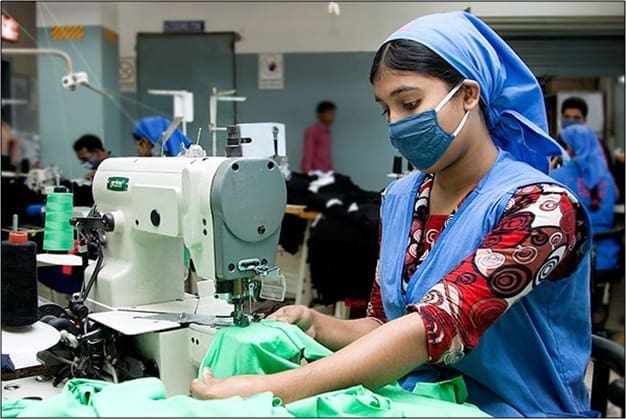Introduction
The textile industry in India traditionally, after agriculture, is the only industry that has generated huge employment for both skilled and unskilled labour in textiles. The textile industry continues to be the second largest employment generating sector in India. It offers direct employment to over 35 million in the country.
India is first in global jute production and shares 63% of the global textile and garment market. India is second in global textile manufacturing and also second in silk and cotton production.
History
The archaeological surveys and studies have indicated that the people of Harrapan civilization were familiar with weaving and spinning of cotton for as long as four thousand years ago. Reference to weaving and spinning materials is found in the vedic literature. There was textile trade in India during the early centuries.
Bengal cotton textiles were the most important manufactured goods in world trade in the 18th century, consumed across the world from the Americans to Japan.
The textile industry was the major component of economic income in India before the English colonies.
Eventually, through colonization, the traditional method of artisan textile production was destroyed, and replaced with large scale factory production.
Indian textile and apparel market drivers
- India represents the largest producer of jute and cotton, and the second largest producer of silk. Due to high abundance of raw materials coupled by cheap labour cost, the cost of manufacturing textile and apparel is significantly lower than many other competing countries.
- India currently has one of the world’s largest young population. Currently around half of the total population is below 25 years of age. This age group represent one of the biggest consumer group of textile and apparel and is expected to drive the spending over the next five years
- Catalyzed by increasing penetration of the Internet, online retailing has witnessed strong growth in the country. Consumers are now looking for is of shopping, multiple options, better offers and easy return policies. The growth in online sales has enabled the textile industry to reach consumers residing across every corner of the nation.
- Due to change in the buying habits, consumers are now shifting from need- based clothing to aspiration- based clothing. Contrary to previous years, where Indian consumers purchase fashion items as and when required, buying clothes has become more than a basic need, it is now reflection of aspiration, personality, and a status symbol. Though basic textile continues to represent a part of the consumer’s basket, the demand for aspirational clothing has increased significantly in recent years.
The textile and apparel market has been segmented on the basic of application which mainly includes clothing, technical, household and fashion. Among these, clothing is the largest segment.
Based on raw materials, the market has been segmented into natural and manmade fibres. Currently, natural fibres represent the largest segment.
On the basics of product type, the market has been categorized into yarn, fabric and fibre. Amongst these, yarn is the most popular product type.
On the regional basis, Maharashtra represents the largest market for textile and apparel in India. Some of the other major market includes Uttar Pradesh, Tamil Nadu, Gujarat and Karnataka.
COVID-19 and Indian textile industry
The covid-19 has cut the Indian textile and fashion industry into bits and pieces. While the export orders from the key markets- the US and UK started to dwindle since the beginning of the Year, domestic sales were also badly hit by demand sluggishness and closure of retail showrooms across the country due to the lockdown.
But disruption is not something next to the fashion industry which needs to keep itself abreast with ever changing consumers taste and preferences. With face masks becoming an inseparable accessory, the textile industry is crafting a special place for itself in the global fashion mask industry.
The Ahmedabad Textile Industry Research Association (ATIRA) in collaboration with the Defence Research and Development Organisation (DRDO) has produced a high quality cloth to make mask of 99% filter efficiency the highest among all kind of mask available in the country.
ATIRA is developing the cloth material for the preparation of five lakh ‘N-99 mask’, which it says would be better in quality then the N-95 mask that have been in huge demand of late in the fight against coronavirus.
The world is challenging COVID- 19 pandemic, which has not left any part of the world to face it. One side lives are been lost as a result of Pandemic, other largest consequences that the world is facing is big downfall in the economy too. This economic crisis has attacked various businesses in and around the world. All sort of travel, hospitality, hotels and restaurants, bar, package food, retail, E-Commerce, automobile etc. One of the severely affected industry is textile manufacturing too.
The textile and clothing sector is labour and capital intensive and majority of workers are migrant labours, and many of them have returned to their native places.
Now the demand of hygiene textile would be very high. No product whether its apparel wear or home textiles, knighted or woven, adults or kids, formal or casual, will have to inbuilt hygiene in it. This trust building up will be key with consumers to regain business at the earliest.
Working on finishes below during development and production will surely help to build up trust with the consumer.
Apparel and home textile industry would focus on a combination of below finishes:
-Antimicrobial/ Anti-viral/ Anti- bacteria
– Water repellents
– Hydrophilic
-Wrinkle free
-Anti-odour, Anti sweating
-Anti pilling (to avoid entrapping of microbial)
– PU coated denims
-Soil release and few more
Governments plan
The government plans to offer collateral free loans to MSMEs. The loans worth Rs. 3 lakh crore will be given to MSMEs with over Rs. 100 crore turnovers. These loans will have four year tenure and a total of 45 lakh MSME units will benefit from the same. For the first 12 months there will be no principal repayment for these loans.
The government has also announced a Rs 5,000 crore equity infusion for MSMEs through Fund of Funds (FOFs). For micro units the investment limit has been raised to Rs 1 crore from Rs 25 lakh. Turnover limit has been introduced at Rs 5 crore.
Businesses with investment of up to Rs 20 crore and turnover of up to Rs 100 crore will be termed as medium enterprises and companies with investment of up to Rs 10 crore and turnover of up to Rs 50 crore will be termed as small enterprises.

Ujjwal Kumar Dey
Chetana’s Institute of Management and Research Mumbai

